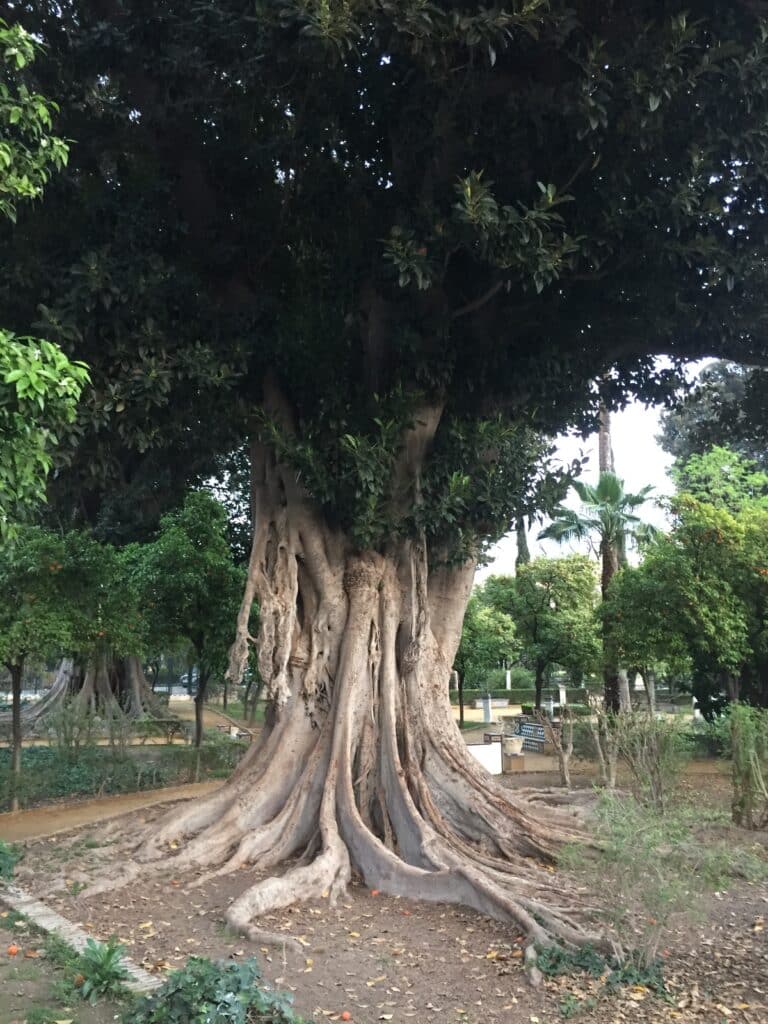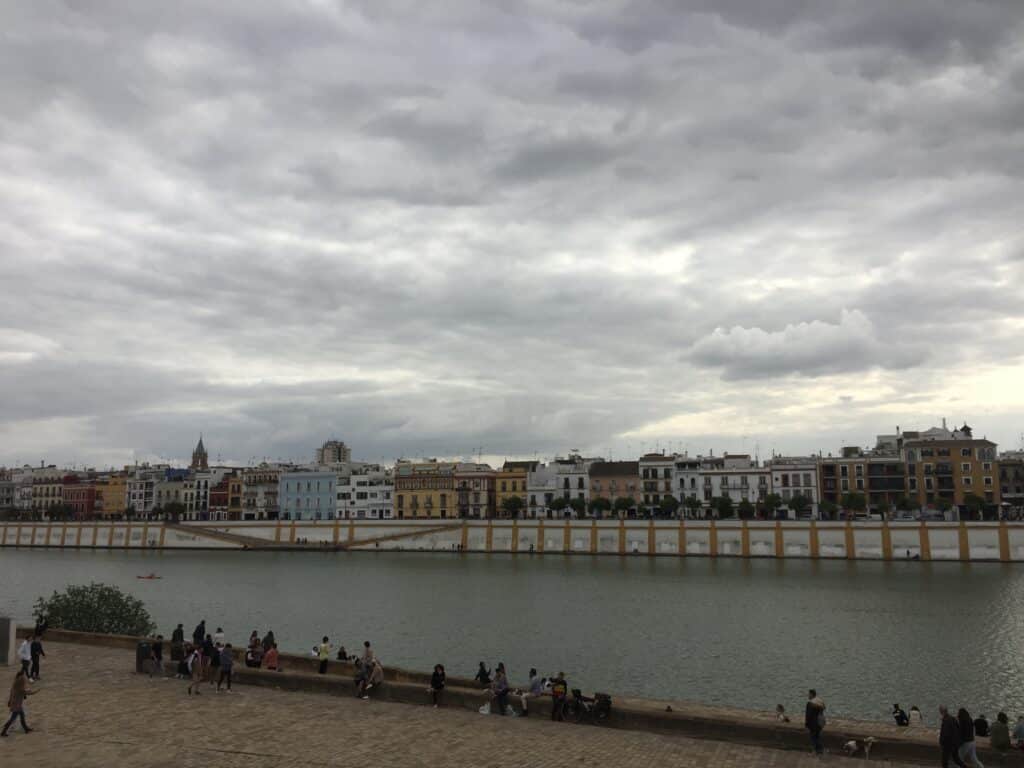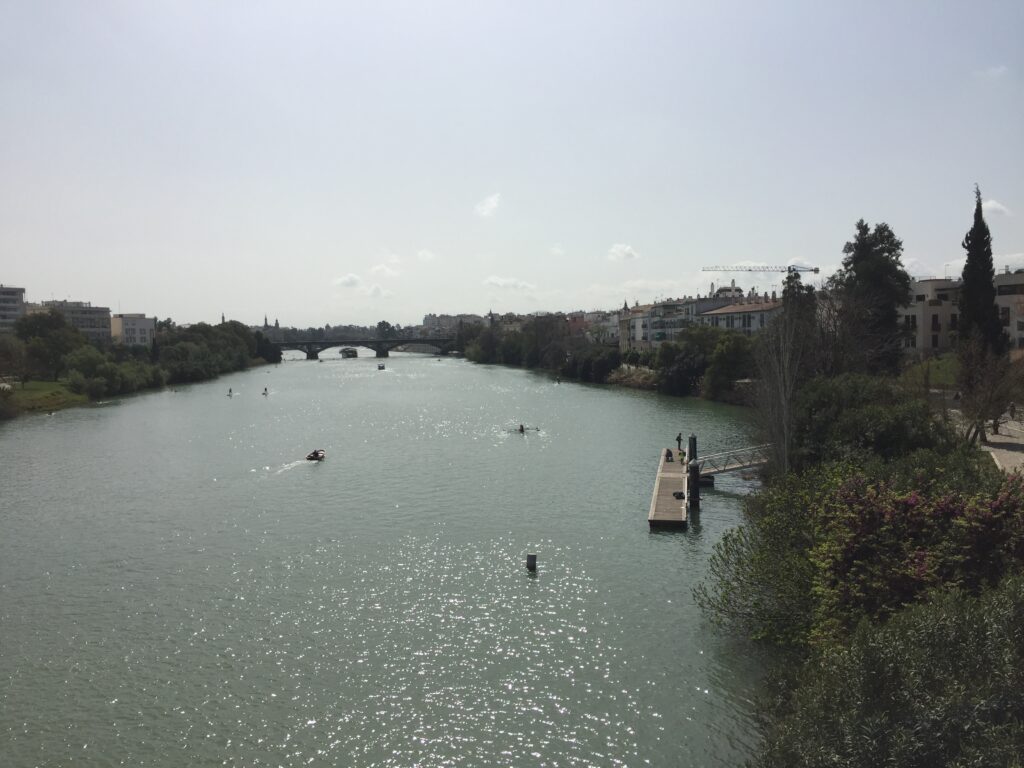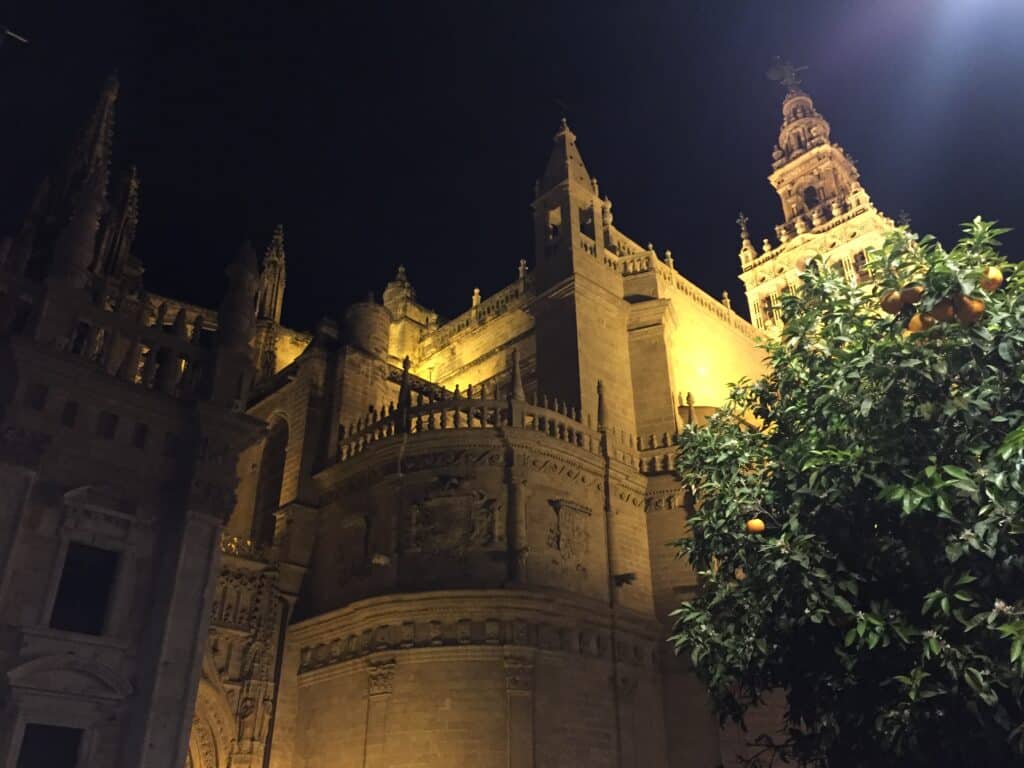Seville is, without a doubt, one of the most beautiful cities I have ever had the pleasure of visiting. By all accounts, I am not the only one who feels that way.
Legend has it that, during one of his less fabled expeditions, Hercules – yes, the one and only; Roman equivalent of the Greek hero Heracles, son of Zeus/Jupiter and a mortal woman, demigod endowed with supernatural courage and strength, etc. – became so besotted with the fertile lands that once distinguished the site where the Guadalquivir River temporarily diverges into two arms, he felt compelled to found a settlement there.
Fast-forward a few thousand years and numerous incarnations ˗ including Hispalis in Roman times and Ishbiliyah after the Islamic conquest of 711 ˗ later, the settlement that Hercules established has matured into a modern-day metropolis with a population of circa 1.5 million.
Renowned for its sunny weather, historical landmarks, delicious tapas, and graceful flamenco dancers, over two million visitors flock to Seville on an annual basis. For once I am delighted to say that, in 2022, I was one of the horde.
First Impressions
I arrived in Seville on a tepid, partly cloudy Thursday afternoon in mid-March. The three hour bus ride from Granada had been comfortable enough and the picturesque landscape of vast green pastures, interspersed with the occasional hacienda, we had journeyed across repeatedly succeeded in distracting me from my reading.
In stark contrast, the eastern suburb through which we had entered the city limits was nowhere near idyllic. Upon finding the main bus terminal in a similar state of decay, I already found myself questioning the hype.
Fortunately, I was not in a position to dwell on any misgivings. There was, first and foremost, the matter of finding a place to rest my head at night. A quick online search conducted before checking out of my hotel in Granada that morning had yielded a few leads so I did have a vague notion of where I was headed, less so of the distances involved.
Half-expecting the trek across Seville’s historic old town ˗ or Zona Monumental ˗ to eat up the remaining hours of daylight, I soon realised the intimidating web of winding streets and thoroughfares that covered the complimentary city map I had obtained at the bus terminal was in fact a welcoming maze of narrow and twisting lanes.

It took the necessary restraint to refrain from veering off the main passageways (that is to say, those capable of accommodating two-way traffic…) and diving head first into the more secluded sections of the labyrinth straight away. Eager to rid myself of the little cabin trolley that bounced excitedly on the cobblestones in my wake, I reached the first hostal on my list within forty-five minutes of exiting the bus.
Into the Labyrinth
As it turned out, the hostal was fully booked throughout the weekend and could only put me up for that night. I decided to check in all the same; at least I would have somewhere to store my stuff whilst I continued my search.
Over the course of the next ninety minutes, I stepped into seven or eight random hotels, hostals, and pensions in the south-eastern section of the Zona Monumental to enquire whether they had space for me on Friday as well as Saturday night. All but one was fully booked, the aberration among them being well out of my price range.
In the end I managed to secure shelter at the Hotel Doña Lina, where the elderly gentleman at the reception desk offered to show me the room before I made my decision ˗ a gesture which was greatly appreciated. Convinced I would not be able to find my way there again the next day, I asked for a business card before plunging back into the labyrinth.
With the bare necessities sorted, the rest of the evening was spent viewing some of Seville’s historical landmarks. I took my sweet time to marvel at the magnificent ficus trees in the Jardines de Murillo, caught a flamenco performance in front of the Plaza de España, and had a tasty ˗ though forcedly rushed ˗ meal in the shadows of the equally grandiose Catedral.

On my way back to the hostal, I crossed paths with some sort of street music procession and let myself be guided by the crowd for a little while. By then any traces of scepticism had been overcome and I was nothing short of excited at the prospect of exploring this fine city for another two full days.
Of Wayfarers and Seafarers
Over the course of those two full days I would cover a fair amount of ground on both banks of the Guadalquivir, in the Zona Monumental on the left and the barrio of Triana on the right.
Time and time again, I felt compelled to stop dead in my tracks and pay due attention to all the intricate features of the delightfully anachronistic cityscape through which I passed. Whether it be a discreet ornamental feature adorning the facade of a thousand year old Moorish house or the interplay between sunlight, ceramic tiles, and citrus trees in small enclosed squares, it had my full consideration. Being in the moment, I believe it’s called.

Seeing that I had weathered several rainy days in Málaga and Granada before rolling into Seville, I was inclined to limit myself to outdoor activities for as long as the sun cared to accompany me. It had actually been one of my main reasons for travelling to Andalusia in the first place; winter back home in the Netherlands had not been particularly harsh but exceedingly grey and dreary, and I had come this far south in search of an early, Mediterranean Spring.
Having finally found just that, the time I would have otherwise spent standing in line to enter the Catedral, Royal Alcázar, and Archivo de Indias was allocated to leisurely pit stops on sunlit terraces from which I could simply watch the world go by.
While the tapas savoured were delicious and the jarras that washed them down more than satisfactory, this approach did ultimately limit my exposure to the heirlooms of the most prosperous era in Seville’s history. An era set in motion by none other than my infamous (partial) namesake: Christopher Columbus.
Christopher Columbus: A Brief Introduction
A prominent historical figure whose life has been researched and written about extensively, scholars tend to agree that Christopher Columbus was born somewhere between August 25 and October 31, 1451 in the port city of Genoa in modern-day Italy. He began an apprenticeship as a business agent for a wealthy Genovese merchant family at the age of twelve and first went out to sea when he was fourteen.
During his younger years, Columbus travelled widely ˗ as far north as the British Isles and all the way down the West African coastline to what is now called Ghana. Records show that he sailed on a Portuguese vessel from Galway to Lisbon in 1477. There he was reunited with his brother Bartolomeo, who ran one of the city’s cartography workshops. Christopher decided to base himself in Lisbon as well and would tie the knot with a Portuguese noblewoman whose father had served as a captain in the navy under Prince Henry the Navigator.
Through his marriage, Columbus had access to the nautical charts and ship’s logs of his deceased father-in-law. In his brother’s workshop, he was privy to the stories of old seamen about their voyages west. Combining this wealth of first-hand information with his self-taught knowledge of astrology, geography, and history, he started developing plans to seek a western passage to the East Indies with hopes of profiting from the lucrative spice trade.
Columbus was not the only one. Ever since the fall of Constantinople at the hands of the Ottomans in 1453, the Silk Road had been closed to Christian traders. This meant that European merchants no longer had a safe land passage along which they could acquire the much sought after commodities of the Indian subcontinent, Southeast Asia, and China.

The Quest for Asia
However high the incentive for the establishment of a sea route, the Florentine astronomer Toscanelli’s suggestion that sailing west across the Atlantic would enable a swift passage to the Spice Islands, China, and Japan was rejected by King Afonso V of Portugal in 1474. Columbus proposed a similar plan to King John II, also of Portugal, some ten years later but this too was rejected by the monarch’s advisors on the grounds that the estimated distance of 2,400 nautical miles (or 4,400 km) was a gross underestimation.
The actual distance is in fact 10,600 nautical miles (19,600 km), although there was obviously no way of knowing this at the time. In any event, no 15th century ship could have carried enough food and fresh water for such a long voyage, and the dangers involved in navigating through uncharted ocean would have been formidable. Hence, the prospect of a westward route from Europe to Asia was deemed unfeasible.
Never one to throw in the towel, Columbus kept knocking on doors until he was granted an audience with King Ferdinand II and Queen Isabella I of Spain in 1486 or thereabouts, but the committee of learned men to which his proposal was referred came to the very same conclusion as their Portuguese counterparts.
Nevertheless, as means of preventing Columbus from taking his ideas elsewhere and thus keeping their own options open, the Spanish sovereigns set him up with an allowance equivalent to that of a sailor’s annual salary. In due time, they would also furnish Columbus with a letter ordering all cities and towns under their dominion to provide him with free food and lodging ˗ a privilege that should have been extended to each and every Christopher in perpetuity, if you ask me!
The Quest for Patronage
Not that these benefits went a long way in securing his unwavering fidelity – Columbus was far too ambitious to let such sentiments hold him back. He unsuccessfully appealed to the Portuguese monarch once more in 1488 and even went as far as dispatching his brother to England with the objective of seeking sponsorship for his proposed expedition in the court of Henry VII. However, in a cruel twist of fate, poor Bartolomeo was captured by pirates en route and did not arrive at his intended destination until early 1491.
By that time, the Catholic monarchs of Spain were on the verge of completing the Reconquista ˗ which had proven to be an extremely expensive endeavour ˗ and were eager to obtain a competitive edge over other European countries in terms of trade with Asia. A formal agreement was struck between Columbus and the Spanish crown in January of 1492, shortly after the capitulation of Granada, the last Muslim stronghold on the Iberian peninsula.
What happened next is all but common knowledge. Later that year, Columbus and his fleet of three ships set sail from Palos de la Frontera and, after a voyage of two months by way of the Canary Islands, made landfall on an island in The Bahamas in mid-October. The convoy subsequently sailed on to the islands now known as Cuba and Hispaniola, establishing a small colony in modern-day Haiti along the way.
In a detailed ‘letter’ on this inaugural voyage, published following his return to Spain in 1493, Columbus claimed to have reached Asia. He also brought with him a number of captured natives ˗ or “Indios”, as he called them ˗ as well as a collection of indigenous plants and birds, and small amounts of gold.
The Dawn of a New Age
Columbus would sail the ocean blue on three further occasions ˗ to the Lesser Antilles in late 1493, Trinidad and the northern coast of South America in 1498, and the eastern coastline of Central America in 1502. All the while, and in the face of mounting evidence to the contrary, he stubbornly refused to acknowledge that the lands he had visited and claimed for Spain were not part of Asia.
Even after Vasco da Gama successfully rounded the Cape of Good Hope and went on to reach the western shores of India in 1498, Columbus never clearly renounced his belief that he had reached the outer fringes of the Far East. This explains, in part, why the American continent was named after the Florentine explorer Amerigo Vespucci, who is credited for recognising it as a “New World”.
In spite of his – in hindsight – laughable doggedness, the voyages of Columbus clearly signify a turning point in human history. Permanent contact between the two hemispheres had been established and a massive exchange of flora, fauna, fungi, mineral wealth, technologies, ideas, and beliefs was brought into motion. The age of globalisation had been inaugurated and, over the course of the centuries that followed, the currents of conquest and colonisation thereby unleashed would come to shape the world as we know it today.
Many of the names Columbus gave to distinct geographical features, such as islands, that he encountered during his travels are still in use and a long list of places in the Western Hemisphere he never actually set foot in bear his own name ˗ like the country of Colombia, the Canadian province of British Columbia, and the District of Columbia, to name a few.

The Harder They Come, The Harder They Fall
In accordance with the terms of agreement set prior to his first excursion, Columbus was given the rank of “Admiral of the Ocean Sea” and appointed both Viceroy as well as Governor of all the new territories he had claimed for Spain. He would also be entitled, in perpetuity, to 10% (diezmo) of all revenues amassed in those territories and have the option of buying a one-eighth stake (ochavo) in any commercial venture undertaken by other parties.
However, Columbus was arrested and dismissed from his posts in 1500. Word of systematic mistreatment and enslavement of the natives of his lands had begun to reach Queen Isabella, who had insisted the “Indios” be counted as potential Christians and treated “well and lovingly, without upsetting them in any way.” Coming from someone who had, in a not too distant past, launched the gruesome judicial institution that was the Spanish Inquisition and expelled the Jews from Spain, it is no wonder that Columbus did not place much weight on these words.
Not that it makes any difference, but it is likely that Columbus conceived his slaving scheme in late medieval terms – religious rather than racial, that is to say. It has been argued that he was a Christian millennialist and apocalypticist, and throughout his adult life he consistently claimed that the conversion of non-believers was the primary aim of his expeditions.
The log books of his voyages are filled with passages alluding to the acquisition of gold “in such quantity that the sovereigns will undertake and prepare to go conquer the Holy Sepulcher” so that a Biblical prophecy may be fulfilled. He also often wrote about converting all races to Christianity, causing some scholars to believe that he was fundamentally motivated by hopes of delivering Jerusalem from Muslim hands.
The Bitter End
The commercial problems plaguing his venture also played a role. Seeking vast stores of silks and spices from the rich bazaars of the Orient, the new territories initially yielded little more than parrots, papayas, and a frustrating pittance of gold. Through the mass export of slaves, Columbus saw a means to get paid. His contemporaries in the colonial administration were almost certainly chasing similar ambitions yet many of them were horrified by the brutality of his methods in doing so.
Although he received the necessary royal support to conduct another expedition after his deportation from Hispaniola, Columbus would remain at odds with the Spanish rulers for the rest of his life. Under claims that the crown had illegally reneged on its contractual obligations as defined in early 1492, Columbus and his sons kickstarted a series of lawsuits that became known as the pleitos colombinos. Their demands were rejected on the basis that the agreement had been nullified the moment Columbus was relieved of his duties as governor.
He returned to Spain from his fourth and final voyage in poor health and settled in Seville in April 1505. From there he continued pleading to the crown to have his privileges honoured, even bracing a trip all the way to Segovia on the back of a mule in order to present himself at the royal court. When this attempt proved futile, Columbus trailed the court to Valladolid in 1506; there he died, aged 54.
His reputation beset by his failures as an administrator, the name Christopher Columbus ˗ or Cristóbal Colón would languish in the backwaters of history for some time. Whereas his star had faded, the city of Seville’s was on the rise again.

The Cycles of History
For all the technical issues caused by its location, circa 80 km inland, Seville was chosen as the headquarters of the Casa de Contracíon in 1503. The Casa had broad powers over overseas matters, especially those concerning trade and the legal disputes arising from it. It was also responsible for the licensing of emigrants, the creation of maps and charters, and the probate of the estates of Spaniards who had passed away on their travels to the New World.
Due to its presence, Seville was the only city awarded a royal monopoly for trade with the growing number of colonies in the Americas. Merchants from other trade centres were thus forced to go to the river port in order to acquire the goods shipped back across the pond. Owing to its role as gateway of the Spanish Empire’s transatlantic trade, Seville grew into one of Western Europe’s largest cities in the 16th century.
The city would continue to flourish for more 200 years. However, the silting of the Guadalquivir gradually made it impossible for the loaded trade vessels returning from the Americas to navigate upstream. This development meant the Casa was relocated to the sea port of Cádiz in 1717 and Seville was thrust into an era of economic and demographic decline.
By then, Columbus had begun to make a resurgence as a character in several poems and plays. His star was elevated to that of a national myth in the post-revolutionary USA towards the end of the 18th century. Representations of that historic landing in The Bahamas in 1492 became a powerful “image of American genesis”. This newfound popularity did little to improve the fortunes of his heirs though. Still diezmo-less after almost three hundred years, they finally decided to discontinue the pleitos colombinos in 1790.
The Real Taste of India
On my final evening in Seville, I took one last stroll through the Zona Monumental. I had partaken in a most unexpected, protracted, and splendid luncheon that afternoon, and my sights were set on a light dinner. Falafel and a salad, to be specific. As I zig-zagged my way through the labyrinth, I once again completely lost all sense of time and purpose.
I existed solely to witness La Giralda glisten in twilight; to be one with the carefree Saturday night crowd at Las Setas and Alameda de Hércules, eyes wandering from one dark-haired, dark-eyed Andalusian belle to the next. With so much beauty all around, why would anyone wish for anything more than the here and now?
After tracing an upright section of the old city wall at the Puerta de la Macarena, I made my way down the main avenues that demarcate the eastern borders of Seville’s historic centre in the direction of the Jardines de Murillo and the Doña Lina. It was already coming up to eleven o’clock and my stomach had started rumbling.
Around the way from the hostal where I had spent my first night in town, I came across an Oriental-themed eatery with a small outside seating area. Not only did they serve massive falafel wraps with a generous portion of salad to boot, their self service cooler was stocked with bottles of Kingfisher.

Despite having spent nearly half my life living in Asia, I could not recall ever having tried India’s number one beer – according to their own marketing department, at least. That night in Seville seemed as opportune a moment as any.
Kingfisher: A Brief History
The roots of this “triumphant tipple” can be traced all the way back to 1857, when Castle Breweries was founded in the city of Mysore. In those days, huge barrels of beer ˗ routinely referred to as “Hog’s heads” ˗ were loaded onto bullock carts and transported to customers around the area.
In 1915, the brewery joined forces with four local competitors to form United Breweries. The company’s staple quickly became a favourite with the British troops stationed in the wider region and carts loaded with Hog’s heads were frequently wheeled all the way to Bangalore, the Nilgiris, and Madras. In the decades that followed, United Breweries further expanded its reach to cover the country’s full vastness, from Kerala in the south to Delhi in the north and everywhere in between.
The launch of the Kingfisher brand in the late 1970s signified the brewery’s introduction to the global beer market. In Europe, it is currently brewed under licence by Heineken ˗ who hold 42% equity in United Breweries ˗ using the exact same recipe as the one applied in India. In an effort to highlight the brand’s genuine heritage, the Kingfisher Premium is marketed as “The real taste of India” – a refreshing beverage that goes well with the heat and spice of even the richest curry.
It is a crisp number, that has to be said, and its deft notes of light, tangy bitterness complemented my falafel wrap perfectly. Even so, the amusement brought about by this fortuitous encounter can primarily be attributed to its transpiring in Seville, of all places, and not to the outstanding quality of the brew itself.
A Philistine’s Final Take
Munching away on my falafel wrap and washing it down with hearty gulps of Kingfisher, my infamous namesake was the furthest thing from my mind. Part of me is ashamed to admit that, at that moment, I did not realise the massive circular fountain complete with pedestal and towering twin columns I had observed in the Jardines de Murillo is in fact a monument dedicated to and named after him. Nor did I have a clue that all those people queueing outside of the Catedral would have had the opportunity to stand in front of his tomb.

In that sense, I really could have put a bit more effort into educating myself about the stories behind the splendour. It is possible that I would have been less bedazzled by the Baroque elements of the cityscape as a result but it would have allowed me to immediately grasp the irony of being treated to a real taste of India in the middle of Seville ˗ just as my infamous namesake had hoped when he embarked on his failed quest for Asia half a millennium ago.
There is also a part of me that has no issues with my frequent philistine indiscretions whatsoever, ignorance being bliss and all. Had I been consciously aware that it had taken the pillaging of an entire continent for Seville to evolve into the sensory spectacle it is today, I may have resented her for it. If I had paid closer attention to the unmistakable Monumento a Cristóbal Colón, I may have been inclined to question whether or not it should be torn down. Luckily, that was not the case – I approached Seville with an open mind and open arms, and she embraced me, along with the rest of the horde.



Leave a Reply